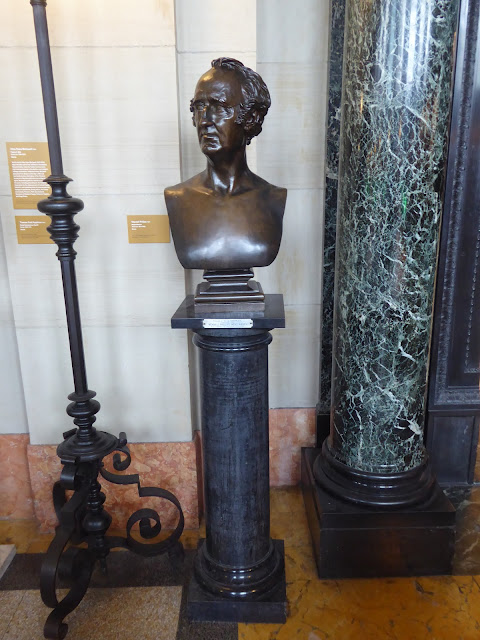Sir Henry Vane
Boston, MA
N 42° 20.974 W 071° 04.644
Short Description:
A statue of the 6th Governor of the Massachusetts Bay Colony, Sir Henry Vane, is located in a niche in vestibule of the Dartmouth Street entrance of the McKim Building of the Boston Public Library.
Long Description:
A 7.8' by 3.5' by 3' bronze sculpture of Sir Henry Vane stands on top of a 3.25' by 2.8' by 2.8' green marble pedestal. Vane is wearing formal 17th attire including shirt with a ruff neck, boots with spurs, breeches, a jacket with large cuffs, a cape, and a hat folded up on the left side. He is holding a coat over his left arm and has a baton tucked into the crook of his right arm. The statue was created by Frederick William MacMonnies in 1893 and cast at Jaboeuf & Bezout Fondeurs.
A bronze plaque on the bronze plinth is inscribed with a quote from the John Winthrop, the 3rd Governor of the Massachusetts Bay Colony:
BUT IT PLEASES GOD TO STIR THEM UP SUCH FRIENDS, VIZ.,
SIR HENRY VANE, WHO HAD SOMETIME LIVED AT BOSTON
AND THOUGH HE MIGHT HAVE TAKEN OCCASION AGAINST US FOR
SOME DISHONOR WHICH HE APPREHENDED TO HAVE BEEN UNJUSTLY
PUT UPON HIM HERE, YET BOTH NOW AND AT OTHER TIMES HE
SHOWED HIMSELF A TRUE FRIEND OF NEW ENGLAND, AND A
MAN OF A NOBLE AND GENEROUS MIND. WINTHROP
A bronze plaque on the base is inscribed:
SIR HENRY VANE
GOVERNOR OF THE
COLONY OF THE MASSACHUSETTS BAY 1636
BORN 1612 BEHEADED 1662
AN ARDENT DEFENDER OF CIVIL LIBERTY AND
ADVOCATE OF FREE THOUGHT IN RELIGION
HE MAINTAINED THAT GOD, LAW AND PARLIAMENT
ARE SUPERIOR TO THE KING
THIS STATUE WAS PLACED HERE AT THE REQUEST OF
JAMES FREEMAN CLARKE, D.D., AN HONORED CITIZEN
OF BOSTON WHO NOBLY LABORED FOR THE ABOLITION
OF SLAVERY IN AMERICA
Sir Henry Vane born in 1613 in Essex, England into a noble family. After studying at Oxford and travelling through Europe he adopted Puritan views and joined the Puritan migration to the Massachusetts Bay Colony. In 1637, Vane was elected governor of the colony.
He became a supporter of Anne Hutchinson who espoused Antinomianism, a belief that existing laws and practices were not necessary for salvation. He also supported the freedom of religion, the cause of Roger William, the establishment of the Rhode Island Colony, and founding of Harvard College.
In 1639 he returned to England to become a position as Treasurer of the Royal Navy and was made a knight by King Charles. He supported Oliver Cromwell's position of freedom of religion over that of King Charles. However after the Parliamentary victory in the First English Civil War, the Presbyterian group in the House of Commons introduced legislation hostile to the views on religious tolerance held by Vane.
The Second English Civil War saw the defeat and execution of King Charles and the formation of a Commonwealth under Oliver Cromwell. Vane headed the committee that reformed the navy, drafted new Articles of War, and formally codifying naval law. Vane and Cromwell disagreed on many domestic issues and Vane retired and formed a religious teaching group, known as "Vanist". After Cromwell's death in 1658, King Charles II was restored to the throne. Vane was arrested on July 1, 1660 on the orders of the King and imprisoned in the Tower of London. He was transferred to He was transferred to the Isles of Scilly in October 1661. He was returned to the Tower of London and on 2 June 2, 1662 he was charged with of high treason against the King. He was beheaded on June 14, 1662.

















































